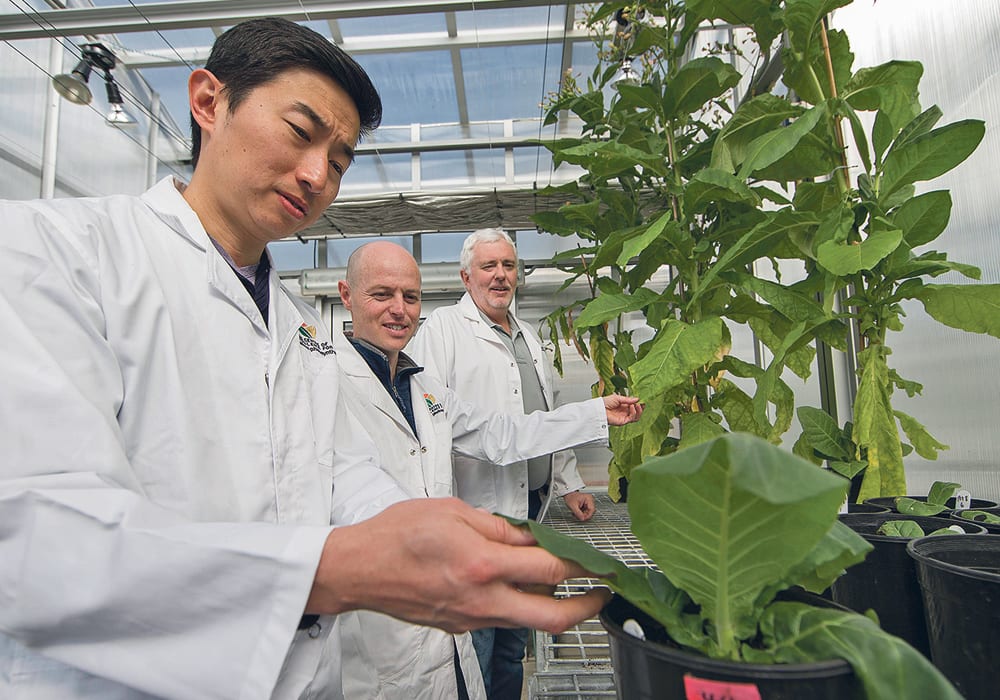Carbon-capturing ‘engines’ found in blue-green algae may help plants capture CO2 more efficiently and boost yields
CHILLIWACK, B.C. — For millions of years, plants have been converting carbon dioxide, water and sunlight into energy for growth through photosynthesis.
The process is controlled by the enzyme Rubisco, which fixes carbon dioxide from the atmosphere. Photosynthesis sets, or limits, the level of crop yield.
Now, plant biologists at the Australian National University are researching how they might change that level and give photosynthesis a boost that could lead to a 60 percent increase in a crop’s yield.
They have been studying the tiny carbon-capturing “engines” found in blue-green algae as a way to help plants capture CO2 more efficiently and boost yields in crops like wheat, rice and cassava.
Read Also

Trade war may create Canadian economic opportunities
Canada’s current tariff woes could open chances for long-term economic growth and a stronger Canadian economy, consultant says — It’s happened before.
Blue-green algae is actually bacteria known as cyanobacteria, which produces energy through photosynthesis. It also produces harmful toxins to people and animals.
It is widely found in Canadian lakes and is a problem where soils have higher levels of phosphorus, which help the bacteria grow.
But the plus side of blue-green algae is that they contain tiny compartments called carboxysomes, which are extremely efficient at turning CO2 into energy-rich sugars.
Like algae, plants use Rubisco to convert carbon into sugars but the problem is that the plant-based enzyme is slow and it can’t always tell the difference between carbon dioxide and oxygen.
“Rubisco is perhaps the most ubiquitous enzyme on the planet,” said Dr. Ben Long, research fellow at the College of Science at the Australian National University.
“An enzyme is a type of protein that catalyzes a chemical reaction and Rubisco is special in that it’s one of few enzymes able to catalyze the construction of complex carbon-based molecules using CO2. Those molecules lead to the construction of energy-rich sugars. However, Rubisco is notoriously slow. It churns through CO2 molecules at a rate of about three per second in most land plants. It also reacts with molecular oxygen sometimes, not being able to tell the difference between the two gases. This leads to the production of wasteful compounds, which need to be re-processed at high energy cost to the plant.”
Consequently, plants produce a lot of Rubisco to ensure transfer of CO2 to sugars. The downside is that the plant leaves devote most of their protein to the enzyme, resulting in a high need for nitrogen fertilizer and little opportunity for the plant to put that protein into grains.
“Cyanobacteria have worked out a different solution to Rubisco’s problems,” said Long. “Instead of spending a lot of protein on Rubisco to make the reaction quicker, they pump CO2 into a special cellular compartment containing the enzyme, so that Rubisco is forced to operate at maximum speed. This means very little oxygen has the chance to be captured, so little energy is wasted.”
The compartment is called the carboxysome and it looks like a large virus. It uses a special form of dissolved CO2 called bicarbonate as its fuel. Special “pumps” on the outer membrane of the cell pump bicarbonate into the compartment housing the Rubisco where the enzyme turns it into sugars three to five times faster than the plant version of the enzyme.
Taking that concept, Long and his team devised a project to fix the plant’s shortcomings by copying cyanobacteria’s compartment technique and genetically introducing the genes for a carboxysome complete with Rubisco into the chloroplasts of a tobacco plant cell.
“This is a serious upgrade to plant photosynthesis, hijacking a system that evolved separately to that of land plants for an entirely different lifestyle,” said Long.” It’s a bit like replacing your old two-stroke lawnmower for a turbo V8. It’s a faster way of getting from A to B, but at the heart of it we’re still using the Rubisco engine. Forming a simple carboxysome in tobacco chloroplasts is proof that we can build the engine. We need to get the bicarbonate fuel injectors working to supply bicarbonate to the carboxysome.”
Using computer models, the research team has shown that upgrading plant photosynthesis to using the cyanobacteria mechanism could dramatically increase plant growth and yield.
According to Long, tobacco plants are ideal in the lab and the field. They are easily modified genetically and behave like many commercial crops.
“Any changes we make can be tested in the field and have some relevance to a real food crop before we make fine adjustments and generate (commercial) crops,” he said. “We expect that successes will be applicable to most crops, although there will be technical difficulties with some.”
According to Long, there is no reason to expect any side effects on human consumption, but crops generated for future use will undergo rigorous testing. He said they are engineering the plants so that the changes are made in the leaf and not the grain.
Years of research are ahead but the value of producing crops with enhanced yield is not lost on anyone who understands the pressure to feed a growing global population.
The research is supported by the Realizing Increased Photosynthetic Efficiency consortium, the Australian Research Council’s Centre of Excellence for Translational Photosynthesis and the Gates Foundation.
The report Carboxysome encapsulation of the CO2-fixing enzyme Rubisco in tobacco chloroplasts was published in Nature Communications.















